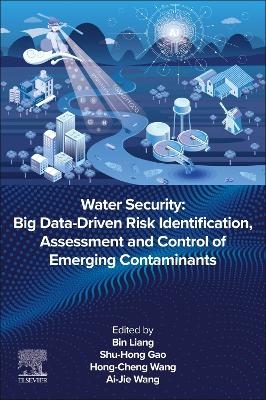
Water Security: Big Data-Driven Risk Identification, Assessment and Control of Emerging Contaminants
Elsevier - Health Sciences Division (Verlag)
978-0-443-14170-6 (ISBN)
Dr. Bin Liang is a professor at Harbin Institute of Technology, Shenzhen, P.R. China. He received his PhD from Harbin Institute of Technology in 2014. Dr. Liang’s research focuses on ecological risk assessment and management of water contaminants. He has systematically investigated the biodegradation mechanisms of emerging contaminants (e.g., antimicrobial agents, refractory organic nitrogen/halide) in water reclamation and treatment systems. He is especially interested in developing green technologies for environmental management and novel methods for environmental monitoring. He has published over 100 Science Citation Index (SCI) papers (18 in high-impact journals ES&T, Water Res and Appl Environ Microbiol), 1 Springer book (as the second editor), 1 standard, and has been authorized 5 patents. His publications have been cited 4000 times, with an H-index of 42. He is a member of the Youth Innovation Promotion Association of the Chinese Academy of Sciences and has won the second prize of the National Technological Invention Award (2020), the first prize of the Environmental Protection Science and Technology Award (2017), the Industry-University-Research Cooperation Innovation Award (2021), and the Microbial Ecology Youth Science and Technology Innovation Award (2015). Dr. Shuhong Gao is an assistant professor at Harbin Institute of Technology, Shenzhen, P.R. China. She received her PhD from The University of Queensland in 2017. Dr. Gao’s research focuses on emerging contaminants in urban water, as well as antibiotic resistance, and pathogens related to wastewater epidemiology. She has systematically investigated microplastic-mediated ecological risks and biosafety in aquatic environments. She is particularly interested in “omics analysis of environmental microbes. She has initiated the construction of Global Water Pathogen Database to unravel the occurrence of pathogens in aquatic systems and to clarify the mechanisms between bio-pollutants transmission and health risks. She presided or participated in over 10 (inter)national/provincial projects. She is the Early-Career Editorial Board member of journal of Environmental Science and Ecotechnology. She has won the Travel Award of 2017 ASM Microbe and the Travel Award of 2019 Chinese Environmental Scholars Forum and was recognized as Overseas high-caliber personnel (Level C) in 2020. She has published over 50 SCI papers (12 in high-impact journals ES&T and Water Res, total citations over 1450), with an H-index of 21.
1. Pollution distribution characteristics and ecological risks of typical emerging chemical contaminants in aquatic environments 2. Microplastics-mediated water ecological risks and control technologies 3. Environmental DNA (eDNA) and toxicogenomics in ecological health risk assessment 4. Dissemination mechanism of antibiotic resistance genes (ARGs) in water environment 5. Environmental behavior and risk of antibiotic resistance genes (ARGs) in water environment 6. Pathogens in engineered water system 7. Environmental ecology and health risk assessment of pathogens in the environment 8. Ecological health assessment of natural water bodies by plankton 9. Analytical approaches, occurrence, migration and transformation mechanisms of emerging contaminants in multiple media 10. Biosensors and Biodegradation for Emerging contaminants based on Synthetic Biology 11. Advanced detection technologies for emerging contaminants based on sensors 12. Optical Real-time Online Sensing Technologies and Challenges for Emerging Contaminants 13. Suspect and nontarget screening technologies for emerging contaminants 14. Detection methods for emerging microplastics 15. High-throughput sequencing based bioinformatics identification technologies for emerging biological contaminants 16. Mining technologies for functional gene markers of emerging contaminants 17. Statistical analysis and visualization of biological sequencing big data 18. Association of antimicrobial biodegradation with the evolution of antimicrobial resistance in ecosystems 19. Microbial Transformation of Per- and Polyfluoroalkyl Substances (PFAS) 20. Microbial dehalogenation mechanisms and prospects of bioremediation of persistent halogenated organic contaminants 21. Bacterial and Genetic Resources for Typical Emerging Pharmaceuticals and Personal Care Products (PPCPs) Degradation 22. Plastic contaminants in water and recent advances for bioremediation 23. Fate of emerging chemical contaminants in wastewater treatment system 24. Fate and risk management of antibiotic resistance genes (ARGs) in anaerobic digestion 25. Electron transfer regulation-based biotechnologies for emerging contaminants treatment 26. Physicochemical control technologies for emerging contaminants in sewage treatment plants 27. Nature-based control technologies for emerging contaminants 28. Leveraging weak electrical stimulation and artificial intelligence for sustainable microbial dehalogenation in groundwater remediation 29. Using isotope tracers to elucidate the fate of organic micropollutants in the environment 30. Modeling processes and sensitivity analysis of machine learning methods for environmental data 31. Advances in pollution source identification in the integrated drainage system 32. Data-driven management strategies for carbon emissions and emerging contaminants control in wastewater treatment plants 33. A Julia based activated sludge modeling program toward emerging contaminants management 34. Mathematical modelling for emerging contaminants during wastewater treatment 35. Current developments in machine learning models with boosting algorithms for the prediction of water quality 36. New situation of water resources management and water pollution control 37. The value of water resources and the emerging contaminants management
| Erscheinungsdatum | 21.08.2024 |
|---|---|
| Verlagsort | Philadelphia |
| Sprache | englisch |
| Maße | 216 x 276 mm |
| Gewicht | 450 g |
| Themenwelt | Naturwissenschaften ► Biologie ► Ökologie / Naturschutz |
| Technik ► Umwelttechnik / Biotechnologie | |
| ISBN-10 | 0-443-14170-3 / 0443141703 |
| ISBN-13 | 978-0-443-14170-6 / 9780443141706 |
| Zustand | Neuware |
| Informationen gemäß Produktsicherheitsverordnung (GPSR) | |
| Haben Sie eine Frage zum Produkt? |
aus dem Bereich


